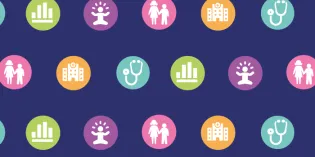What is monthly reporting?
As specified in the Round 4 (2022-25) contract, our commissioners, HQIP (Healthcare Quality Improvement Partnership), asked that we refresh data on our key performance metrics at frequent intervals and publish in the public domain in an online interactive format.
After a period of quarterly reporting and as of April 2024, outputs are refreshed on a monthly basis. All results are provisional until the cohort's annual data submission deadline.
You can view the dashboard for the Epilepsy12 key performance indicators in the next section.
- What are the benefits?
-
Clinical teams receive more timely data on the performance of their paediatric epilepsy service, allowing:
- early identification of areas with low performance which may need improvement
- regular monitoring of performance metrics over time
- more frequent benchmarking data to compare Trust/Health Board data with peer services
- additional quality assurance of data prior to annual report analyses and publication.
Performance data are available at several layers, including: Trust/Health Boards, Integrated Care Boards, NHS England Regions, OPEN UK Networks and nationally (England, Wales and England and Wales).
Trust/Health Board Medical Directors and senior management, ICB and regional leads, NHS England and the Welsh Government can review performance between and within regions and use these data to inform change and quality improvement in paediatric epilepsy care.
Children, young people and their families can also access aggregated data and view how their services are performing on key care metrics compared to regional and national averages. Patients and families have access to more information to gain a better understanding on the quality of care provided by their epilepsy services.
- What data is included?
-
Only data from children and young people whose first year of care forms have been completed before the specified download date in each month are included in the reports. Children will be assigned to a cohort depending on the date of their first paediatric assessment. Data collection for each cohort ends in January of each year. Data are cumulative across the twelve months of a year; however, yearly cohorts remain distinct.
Only data for the 10 Epilepsy12 key performance indicators are refreshed in the monthly outputs and these are provided at Trusts/Health Board, Integrated Care Board and regional and national (England, Wales and England and Wales combined) levels. These results are provisional until the final annual analyses are completed for each cohort.
All other analyses are only performed at the end of the cohort when preparing the annual report.
Epilepsy12 key performance indicators
We report on our performance indicators in the public domain on a monthly basis, starting with patients in cohort 5 (first paediatric assessment between 1 December 2021 and 30 November 2022). Cohort 6 and cohort 7 data can also be viewed on the dashboard. These analyses are limited to cohort 5-7 patients and only data from those first-year care forms completed before the download date specified below are included.
Cohort 5 and 6 data have been quality assured and are the final cohort results. Cohort 7 data are still provisional until the annual analyses is completed in 2026.
Click the double-ended arrow on the bottom right-hand corner to view the dashboard in full-screen mode or view dashboard in a new browser window. We recommend using a large screen.
Download date for cohort 7: 8 October 2025
Please note that these data are provisional and may be subject to change between monthly updates and before the annual report publication.
Guidance
We have created a video and PDF guide to help you use the dashboard and interpret the data. We encourage you to look through these and read the below FAQs to ensure that you fully understand the dashboard and the data within.
Watch the 10-minute video guide
More information about our performance indicators can be found in our Round 4 methodology overview (as a download) on our methodology and data submission page. Our reports and resources page hosts previous annual reports and accompanying outputs.
FAQs
- Why are reports being shared monthly?
-
As specified in the Round 4 (2022-25) contract, our commissioners, HQIP (Healthcare Quality Improvement Partnership), asked that we refresh data on our key performance metrics at frequent intervals and publish them in the public domain in an online interactive format.
After a period of quarterly reporting and as of April 2024, outputs are refreshed on a monthly basis.
You can find the benefits of monthly reporting at the top of the page.
- How do I navigate through the dashboards/what do the different tabs show?
-
Each tab shows our data at a different level of geographical granularity. You can view our performance indicators at the national level, as well as compare by country, OPEN UK network, NHSE region, ICB and Trust/Health Board.
Clicking on the home icon at the top left of a page will take you to the navigation panel.
- Why are some data points replaced by asterisks?
-
Small numbers have been replaced with asterisks in these reports. This has been done to protect patient confidentiality and ensure no patient-identifiable information is published in the public domain, we have replaced any values where there are only one or two CYPs with asterisks. This is in line with the RCPCH data disclosure risk management policy.
There are roughly 2000 children and young people with epilepsy in England and Wales in each cohort. When drilling down to region, ICB and Trust/Health Board level, these numbers get smaller. Additionally, when considering sub-groups of patients, such as those for some indicators eg. Sodium valproate, there may be very small numbers.
In the past, the majority of data is submitted at the end of the year before the January data submission deadline. These data entry patterns mean that our Q1-Q3 reports are likely to have relatively small amounts of data. When numbers fall below 3, this risks patient confidentially and the data has subsequently been suppressed.
When whole graphs and tables have been replaced with asterisks, the plots have been removed from this view. It is important to consider small numbers and how these can affect the performance percentages when interpreting the data presented here.
If you are a clinician submitting Epilepsy12 data, you can improve the data within our dashboards and its utility to your service, by submitting patient data prospectively throughout the year.
- What's the difference between 0%, NA and No data?
-
- 0% means that the site scored 0% on that performance indicator.
- 'NA' means that none of the patients at the selected site have met the eligibility criteria for that measure.
- 'No data' means that the selected site submitted no data for that measure.
- '*' represents small numbers which have been suppressed/masked for patient confidentiality.
If your region states 'NA' for all data points, it means that some patients' records have been completed but none of them have a diagnosis of epilepsy, meaning that they are not eligible for any of the performance indicators.
If your region states 'No data' for all data points, it means that no patient records have been completed in that region.
- When are reports updated?
-
For cohort 7, dashboards are updated monthly. Specific download dates are indicated below each report and only data submitted before this will be included in the analyses.
- Why doesn’t my Trust/Health Board’s data look right?
-
If you notice any errors in our reports, please let us know by emailing epilepsy12@rcpch.ac.uk. These data are provisional and allow for extra quality assurance where data entry or analysis errors can be corrected before the annual cohort analysis and reporting.
If your Trust/Health Board has not submitted and locked any first year of care data for this cohort before the download date, then your data will show 'No data'. Whereas a value of zero signifies 0% performance on this metric.
- Why has my data changed drastically between reports?
-
Monthly outputs only represent the data submitted by each download date. If data is not submitted prospectively, for example, if more data is submitted in the last month, each monthly report will differ from the previous update and may be very different from the annual report. This may also affect how your data compares to your peers and to regional/national averages and it is important to keep this in mind when interpreting the data presented here.
If you are a clinician submitting Epilepsy12 data, you can improve the data within our dashboards and its use by your service, by submitting patient data prospectively throughout the year.
Contact
Please contact the Epilepsy12 team at epilepsy12@rcpch.ac.uk with any queries regarding the data displayed on this page.
We are still developing this dashboard and welcome any suggestions on how we can improve the layout, content and function. Please email the team with any comments or suggestions.
Disclaimer
These tools and documents were specifically developed for use within the Epilpesy12 National Clinical Audit. These tools have been made publicly available and should you choose to download them for uses outside of Epilepsy12, you are free to do so, but are hereby agreeing to enter into a royalty-free, non-exclusive, licence agreement with Healthcare Quality Improvement Partnership (HQIP) under the following terms and conditions:
All information, software, products and related graphics contained in the audit tool or data collection form are provided for non-commercial purposes "as is" without warranty, including but not limited to the implied warranties of satisfactory quality, fitness for a particular purpose, title and non-infringement of third party intellectual property rights. In no event shall HQIP be liable for any direct, indirect, incidental, special or consequential damages for loss of profits, revenue, data or use incurred by you or any third party, whether in action in contract, tort, or otherwise, arising from your access to, or use of, the audit tool or form. HQIP make no representations about the suitability, reliability, timeliness and accuracy of the information, software, products and related graphics contained in the audit tool or forms. HQIP reserves the right to make improvements, changes or updates to forms or tools at any time without notice.










